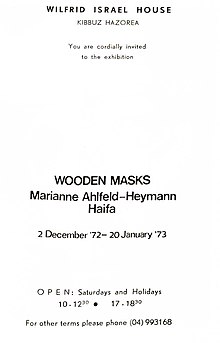Marianne Ahlfeld-Heymann
Marianne Ahlfeld-Heymann (born Marianne Heymann February 7, 1905 in Cologne ; died June 26, 2003 in Haifa ) was a German-Israeli wood sculptor, costume designer, stage designer, mask carver and puppet maker.
Life
Marianne Heymann grew up in the Voigtelstr. 9 in Cologne-Braunsfeld with her mother Elisabeth Heymann. She attended the Kaiserin-Augusta-Gymnasium and in 1922, like her cousin Margarete Heymann , began training at the Cologne School of Applied Arts . In 1923 she moved to the Bauhaus in Weimar and attended Oskar Schlemmer 's class for sculpture and theater. She worked her way into marionette carving. She was particularly impressed by the lecturer Paul Klee and made friends with his son Felix Klee .
When wood carving was given up when the Bauhaus moved to Dessau in 1925 , Heymann returned to Cologne and made puppets for a puppeteer. After attending expressive dance performances by Mary Wigman and the Javanese artist Raden Mas Jodjana , she created masks that were used in dances. From 1926 to 1928 she did a traineeship in set and costume design at the Cologne Opera with Hans Strohbach , then moved to the Mannheim National Theater as assistant to the set designer Eduard Löffler . In 1929 she designed costumes for the production of the opera Hoffmanns Erzählungen in Cologne. She designed numerous productions in Mannheim and Cologne a. A. Der Freischütz (Cologne 1928), The story of the soldier (Cologne 1928), the power of fate (Mannheim 1929), Peterchens Mondfahrt (Mannheim 1930).
After the handover of power to the National Socialists , she fled to Paris via Ascona in April 1933 . She found employment as a draftsman in a workers' commune in Saint Maur, where she met the carpenter Hermann Ahlfeld (1892–1983) from Berlin, who in 1939 legalized their relationship. In 1937 she received an award for costume jewelery at the Paris World Exhibition and in 1938 she commissioned a puppet performance of a play by the Belgian author Maurice Maeterlinck .
Hermann Ahlfeld was interned after the start of the war in 1939 , and she too was taken prisoner in May 1940 for a few months in Camp de Gurs . The Ahlfeld couple survived the war and the persecution of the Jews in southern France, hiding from the Germans, and had three children. In January 1949 they emigrated with the Aliyah to Israel, where they set up a joinery and a carving workshop in the Moshav Kfar Chaim . They produced household items from olive wood with varying economic success.
Ahlfeld-Heymann was already in Haifa for three theater productions in 1936/37: Georg Büchner: Leonce and Lena, Haifa 1936/37; Wolfgang Amadeus Mozart: Abduction from the Seraglio, Haifa 1937; William Shakespeare: What you want, Haifa 1937 and Igor Stravinsky: The story of the soldier, Haifa 1952.
In 1950 Ahlfeld-Heymann exhibited marionettes and masks in Tel Aviv for the first time, but without any particular response. In 1954 the family moved to Haifa. Ahlfeld-Heymann continued to work artistically for a good 30 years and also exhibited repeatedly, for example masks in the Wilfrid Israel Museum at the end of 1972 .
Marianne Ahlfeld-Heymann wrote her memoirs in German in 1955, which she presented to Gretel Baum-Meróm in 1993 . They were published in Germany in 1994 by Erhard Roy Wiehn .
As part of the NRW joint project 100 years of bauhaus im west , the Museum of Applied Arts Cologne is showing retrospective 2 of 14 in 2019. Two Cologne women at the Bauhaus with works by Margarete and Marianne Heymann.
Parts of the graphic estate can be found in the theater studies collection of the University of Cologne.
Honor and commemoration

On March 19, 2019 , stumbling blocks for Marianne Ahlfeld-Heymann and her mother Elisabeth Heymann were laid in front of the Heymann family's former home, Voigtelstrasse 9 in Cologne-Braunsfeld .
Contributions
- Joseph Gregor: The masks of the earth . Munich: Piper, 1936, p. 25 and plate 89
- Hansi Fuchs : Chimeras: Poems . Cover drawing by Marianne Heymann. Paris: Rhenus, 1938
- Marianne Ahlfeld-Heymann, Erhard Roy Wiehn (ed.) And still survived. A Jewish fate from Cologne through France to Israel 1905–1955. With memories of Paul Klee . Constance: Hartung-Gorre, 1994 ISBN 9783891917305
literature
- Julia Franke: Paris, a new home? Jewish emigrants from Germany 1933–1939 . Berlin: Duncker & Humblot, 2000 (contains biographical information p. 378–414)
- Gabriele Mittag (Ed.): Gurs. German émigrés in French exile . Berlin: Argon, 1991
- Hedwig Brenner: Jewish Women in Fine Arts - A Biographical Directory . Preface by Pnina Navè Levinson and Margarita Pazi . Konstanz, 1998, ISBN 3-89649-199-7
- Volkhard Knigge , Harry Stein (ed.): Franz Ehrlich . A Bauhaus member in the resistance and concentration camp. (Catalog for the exhibition of the Buchenwald and Mittelbau-Dora Memorials Foundation in collaboration with the Klassik Stiftung Weimar and the Bauhaus Dessau Foundation in the Neues Museum Weimar from August 2, 2009 to October 11, 2009.) Weimar 2009, ISBN 978-3-935598- 15-6 , p. 140
Web links
- Literature by and about Marianne Ahlfeld-Heymann in the catalog of the German National Library
- Literature by and about Marianne Ahlfeld-Heymann in the bibliographic database WorldCat
- Marianne Ahlfeld-Heymann , at Cologne Women's History Association (Wiki)
Remarks
- ↑ Museum of Applied Arts Cologne | 2 of 14. Two women from Cologne at the Bauhaus. Retrieved December 18, 2018 .
- ↑ Sabrina Steiger: For the "Verdötschten Jüdd": Carnivalist Hans David Tobar and family honored. March 19, 2019, accessed on March 24, 2019 (German).
| personal data | |
|---|---|
| SURNAME | Ahlfeld-Heymann, Marianne |
| ALTERNATIVE NAMES | Heymann, Marianne (maiden name) |
| BRIEF DESCRIPTION | German-Israeli wood sculptor |
| DATE OF BIRTH | February 7, 1905 |
| PLACE OF BIRTH | Cologne |
| DATE OF DEATH | June 26, 2003 |
| Place of death | Haifa |

